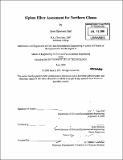| dc.contributor.advisor | Susan Murcott. | en_US |
| dc.contributor.author | Ziff, Sara Elizabeth | en_US |
| dc.contributor.other | Massachusetts Institute of Technology. Dept. of Civil and Environmental Engineering. | en_US |
| dc.coverage.spatial | f-gh--- | en_US |
| dc.date.accessioned | 2010-03-25T14:57:05Z | |
| dc.date.available | 2010-03-25T14:57:05Z | |
| dc.date.copyright | 2009 | en_US |
| dc.date.issued | 2009 | en_US |
| dc.identifier.uri | http://hdl.handle.net/1721.1/53074 | |
| dc.description | Thesis (M. Eng.)--Massachusetts Institute of Technology, Dept. of Civil and Environmental Engineering, 2009. | en_US |
| dc.description | Includes bibliographical references (leaves 97-99). | en_US |
| dc.description.abstract | The siphon filter is a household water filter developed by the Basic Water Needs Foundation based on the design of ceramic candle filters. The siphon filter is marketed under brand names CrystalPur and Tulip and is sold for roughly US$10. An independent Dutch laboratory found log reductions of 4.4-5.5 for the filter, and the filter features flow rates of roughly 3-5 liters per hour. This thesis evaluates the viability of the siphon filter for households in Northern Ghana, where water- borne diseases are a serious issue. With the help of Pure Home Water, a social enterprise that sells household water treatment and safe storage technologies in Northern Ghana, a field study was conducted in twenty-four (24) households in this region. The study consisted of household visits, water quality analysis and an Effective Use survey, which determined how properly the technology was used. Households drinking low and high turbidity source waters were studied, from a mix of middle and lower class households. A preparatory study was conducted at a MIT laboratory prior to the Ghana field study in order to be most effective during the field study. Initially, the field study was designed to avoid recontamination of siphon filtered water samples by taking filtered water samples directly from filter taps rather than sampling lower (post-filtration) container water. However, six (6) of forty-eight (48) filtered water samples showed higher levels of contamination than household stored water samples, indicating that recontamination occurred despite sampling directly from taps. | en_US |
| dc.description.abstract | (cont.) Two possible causes of recontamination included bacterial regrowth within the filter, and filter taps resting in dirty lower water containers or touched by dirty hands. Recontamination is believed to have been due to the latter cause, but further research is needed to confirm this conclusion. The average percent removal of total coliform was 90.7%, and the average positive percent removal for E. coli of 94.1% (these values do not include the five and three samples respectively showing negative percent removals for total coliform and E. coli). However, these values may have been affected by recontamination and true filter performance may have been more effective. A post-filtration safe storage container design is recommended for the siphon filter to maintain the microbial quality of filtered water, and additional testing of the siphon filter with a safe storage container is advised. The distinction between middle and lower class households was not found to influence how effectively the filter was operated. Use of high turbidity water was found to affect filter performance in households: the filter clogged frequently with high turbidity water, partially because study participants did not consistently maintain the filter. Filter maintenance is less crucial for households drinking low turbidity water, and the filter clogged infrequently for these households, even with little maintenance. Alternative household water treatment technologies are compared to the siphon filter for use in households drinking low and high turbidity source waters in Northern Ghana. These technologies include chlorine, alum (coagulation), and the Kosim ceramic pot filter. | en_US |
| dc.description.abstract | (cont.) If the siphon filter recontamination issue were resolved, the siphon filter would be recommended for households drinking low turbidity water in Northern Ghana over the other treatment options considered. The siphon filter is recommended over chlorine for low turbidity water because chlorine is consumable and requires a substantial wait for treated water, while the siphon filter is more permanent and requires little wait for treated water. Alum plus chlorine treatment is recommended for most households drinking turbid water, with the siphon filter as an alternative treatment method for households desiring a more permanent treatment technology, again if the siphon filter recontamination issue were resolved. The siphon filter is preferred over the Kosim filter because while the Kosim filter can only be cleaned by scrubbing and features a slow flow rate, the siphon filter can be kept clean by other methods (e.g. backwashing) before scrubbing is needed, and has a considerably faster flow rate. Keywords siphon filter, household water treatment and safe storage, safe drinking water, water quality. | en_US |
| dc.description.statementofresponsibility | by Sara Elizabeth Ziff. | en_US |
| dc.format.extent | 114 leaves | en_US |
| dc.language.iso | eng | en_US |
| dc.publisher | Massachusetts Institute of Technology | en_US |
| dc.rights | M.I.T. theses are protected by
copyright. They may be viewed from this source for any purpose, but
reproduction or distribution in any format is prohibited without written
permission. See provided URL for inquiries about permission. | en_US |
| dc.rights.uri | http://dspace.mit.edu/handle/1721.1/7582 | en_US |
| dc.subject | Civil and Environmental Engineering. | en_US |
| dc.title | Siphon filter assessment for Northern Ghana | en_US |
| dc.type | Thesis | en_US |
| dc.description.degree | M.Eng. | en_US |
| dc.contributor.department | Massachusetts Institute of Technology. Department of Civil and Environmental Engineering | |
| dc.identifier.oclc | 501946335 | en_US |
